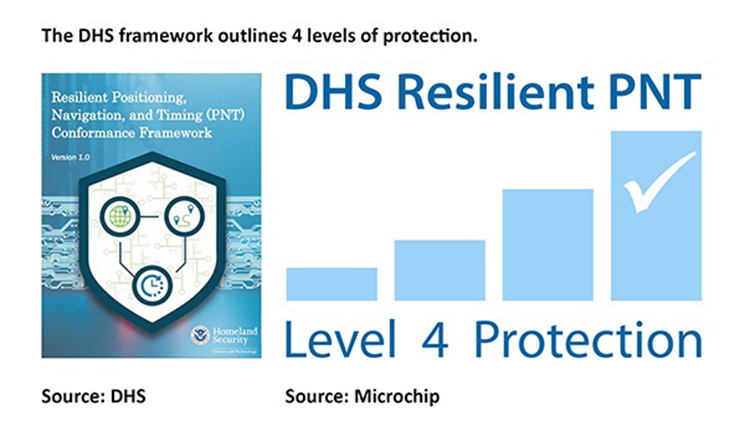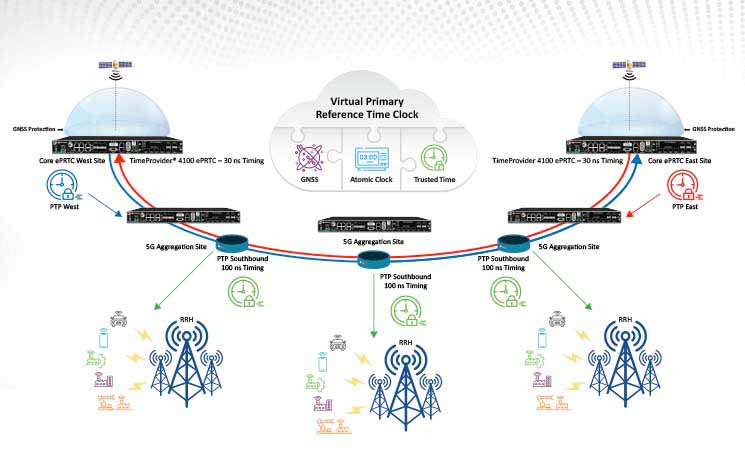Prior generation wireless networks relied heavily on the Global Navigation Satellite System (GNSS) to provide a traceable time reference for all the source clocks in the Radio Access Network (RAN). Well-engineered GNSS-based clocks can easily provide +/- 100 ns Primary Reference Time Clock (PRTC) timing accuracy. Table 1 shows the timing accuracy for common source clocks as defined by the ITU for use in communications networks.
| Clock Type | Accuracy | ITU standard | Comment |
| PRTC – A | 100 ns | ITU-T G.8272 | Single band GNSS |
| PRTC – B | 40 ns | ITU-T G.8272 | Typically, dual-band GNSS |
| Enhance PRTC (ePRTC) | 30 ns | ITU-T G.8272.1 | Combines GNSS with a local Cesium Atomic Clock at core sites to provide an autonomous timescale that can maintain timing if GNSS is lost. |
Table 1. Primary Reference Time Clock (PRTC) types available for 5G.
4G wireless networks have been built out with high-capacity GNSS traceable (PRTC-A) PTP grandmaster clocks located in core RAN sites. Can the 4G core RAN clocks cover all 5G timing needs?
5G Challenge with GNSS
5G operators face two major challenges with deployment of GNSS-based source clocks.
First, 5G networks are very dense, often requiring ten times as many source clocks compared to prior generation networks. That means ten times as many GNSS antennas to install and maintain. GNSS antennas are already installed in core/RAN sites, but not out in 5G aggregations sites. GNSS antennas are a headache you would rather avoid!
And second, GNSS is vulnerable to cybersecurity attacks such as jamming and spoofing. Your 5G radios have a minimum holdover time and will quickly begin interfering with other radios in the same spectrum if GNSS is compromised due to failures or other vulnerabilities such as jamming.
Are GNSS Cybersecurity Threats Real?
In a word – yes. And, government agencies are finally stepping forward to do something about it. If you don’t believe GNSS threats are real, spend a few minutes searching them out on the internet. Frankly, it has become common place and is now classified as a matter of public safety. The below table shows some of the recent government actions to address this cybersecurity threat.
| Action | Date |
| Executive order on strengthening national resilience through responsible use of Position Navigation and Timing (PNT) services | February 2020 |
| US National Space Policy – Key initiatives to improve Cybersecurity for GNSS systems | December 2020 |
| Department of Homeland Security (DHS) Resilient PNT Conformance Framework | December 2020 |
Table 2. Government initiatives to address GNSS cybersecurity.
What do I need to do to adhere to the new DHS Resilient PNT Framework?

Level 1 means your 5G network will go offline during a GNSS threat, but it will self-recover when GNSS service resumes. Not a great experience for your customers. Levels 2 and 3 outline incremental levels of protection, but the DHS call to action is to engineer critical infrastructures for Level 4 security. Level 4 protection means your 5G system will be able to detect and mitigate the GNSS threat and continue to operate without any degradation of services.
How Can Microchip Help Achieve DHS Level 4 Protection?
Microchip’s innovative new timing architecture – the virtual Primary Reference Time Clock (vPRTC) – uses protected core ePRTC timing sites as redundant area timing hubs for your network. Our TimeProvider® 4100 ePRTC connects with your core cesium atomic clocks to combine the internal GNSS reference with the atomic clock to provide an autonomous timing reference for your 5G network.
The ePRTC achieves 30 ns accuracy when locked to GNSS and can maintain 100 ns accuracy for a minimum of 14 days if GNSS is lost. This architecture helps to deliver a new resiliency – which in turn helps network operators provide uninterrupted services to their clients.

The above diagram shows how redundant core ePRTC sites can be deployed for a 5G network. Bidirectional protected Precision Time Protocol (PTP) timing flows from the “west” and “east” core ePRTC sites to all 5G aggregation sites. Most communications networks use ring or mesh architectures with bi-directional traffic flows for high availability even if fiber cuts occur that may disrupt traffic flows in one direction. Ring and mesh architectures can also be configured for bi-directional redundant timing flows. Operators and optical equipment suppliers have presented technical papers on similar timing architectures at the International Timing and Synchronization Forum (ITSF) conference in November 2021 2, 3, 4 demonstrating field results supporting timing accuracy and resiliency.
Microchip’s TimeProvider 4100 clocks at 5G aggregation sites are configured in High Performance Boundary Clock (HPBC) mode to receive timing from the core “east” and “west” sites with an error budget of less than 5 ns. If timing flow from the west is lost, the clock will instantly switch to the protected east flow to maintain required timing accuracy for the network without the need for a GNSS receiver at the aggregation sites.
The southbound PTP flow out to the RRHs is protected by the bi-directional timing flows from the core east and west ePRTC sites. Your core timing sites can also be protected with the BlueSky™ GNSS Firewall technology to monitor GNSS observables, detect potential jamming or spoofing threats and shield them from impacting core ePRTC sites.
Microchip’s entire vPRTC architecture is managed and monitored with our latest TimePictra 11 Synchronization Management System.
Managed and monitored by Microchip’s TimePictra 11 Synchronization Management System, the vPRTC architecture reduces dependency on GNSS for your 5G network and meets DHS Level 4 protection for PNT resiliency. To learn more about this innovative timing architecture for your 5G network, visit this page. And, check Microchip’s website for more information about our total vPRTC solutions.
References:
- Department of Homeland Security; Resilient Positioning, Navigation, and Timing (PNT) Conformance Framework Version 1.0. December 2020.
- Helmut Imlau, Deutsche Telekom, “Resilience for Timing & Synchronization Networks,” International Timing and Synchronization Forum, November 2021.
- Helmut Fabian, A1 Telekom, “Implementation of Reliable Synchronization for 5G,” International Timing & Synchronization Forum, November 2021.
- Jon Baldry, Infinera, “Key Enablers for Migration to Timing Cloud Synchronization Distribution in Optical Transport Networks,” International Timing & Synchronization Forum, November 2021.)

